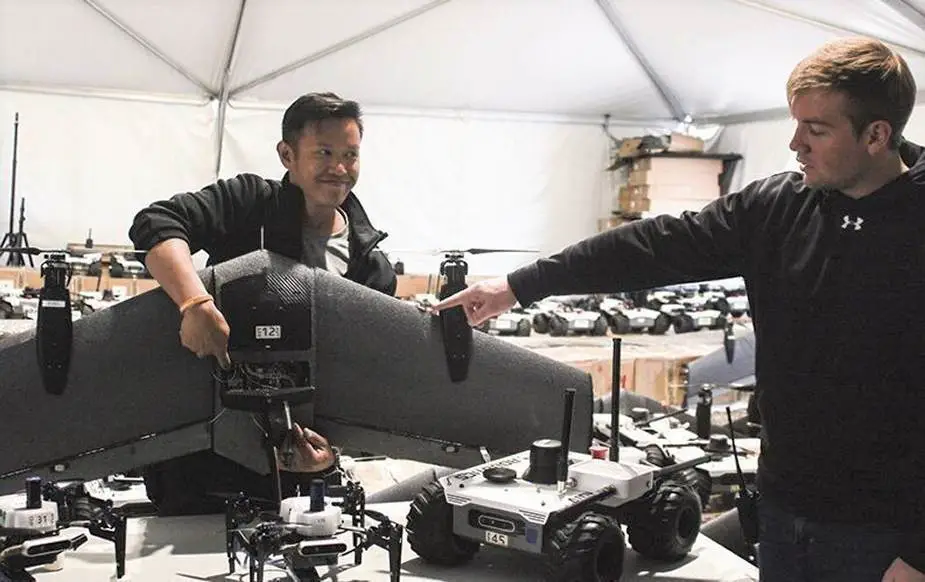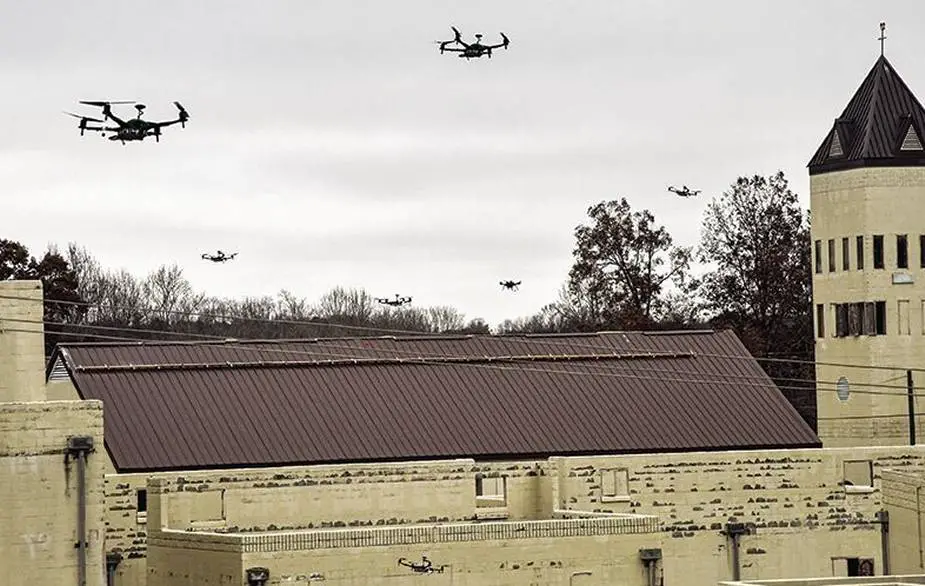Breaking news
Fort Campbell hosts final field experiment for US Army large-scale drone program.
The 101st Airborne Division (Air Assault) and its tenant units are at the forefront of warfighter innovation technology, and the installation’s partnership with the Defense Advanced Research Projects Agency is now driving the future of drone development. Ethan Steinquest reports on U.S. Army’s website.
Follow Army Recognition on Google News at this link

Dan Nguyen, systems engineer, Northrop Grumman, left, and Adam Seiwert, software engineer, Northrop Grumman, give attendees a closer look at the unmanned vehicles used in the OFFensive Swarm-Enabled Tactics, or OFFSET, program during its final field experiment at Fort Campbell’s Cassidy Range Complex Nov. 16. Researchers with the Defense Advanced Research Projects Agency, or DARPA, designed OFFSET with the goal of allowing infantry units to use swarms with upwards of 250 drones to accomplish diverse mission objectives in urban environments. (Picture source: Ethan Steinquest)
Fort Campbell hosted the final field experiment for DARPA’s OFFensive Swarm-Enabled Tactics, or OFFSET, program on Nov. 16 at the Cassidy Range Complex, allowing Soldiers and Department of Defense representatives alike to observe and provide feedback on technology that could allow a single service member to operate hundreds of drones at once.
“We are interested in developing very large-scale teams of air and ground robots operating in support of small unit forces in complex urban environments,” said OFFSET program manager Timothy Chung, with DARPA’s Tactical Technology Office. “Large-scale teams could mean hundreds of robots in concert, but I don’t want 100-250 Soldiers or Marines running around with joysticks in their hands, heads down,” Chung said. “We would rather be able to orchestrate how these swarms of robots go out with a single operator working alongside a swarm commander.”
OFFSET began in 2017 with the vision of discovering and developing technologies to enable advances in collaborative swarm autonomy as well as human-swarm teaming capabilities. During that time, the program has tested its capabilities through field experiments at installations across the country: Camp Roberts, California; Fort Benning, Georgia; Camp Shelby Joint Forces Training Center, Mississippi; Joint Base Lewis-McChord, Washington; and finally, Fort Campbell, Kentucky. “Fort Campbell offers a good balance of the complexity of the environment and access to interesting features,” Chung said. “We have everything from multi-story buildings to long corridors and rows of buildings that would really stress test a lot of our robotics systems, and by and large that’s a key element.”
DARPA’s research performers have developed both tablet-based and virtual reality interfaces to control drone swarms, and they used them to deploy over 100 robots across Cassidy Range Complex to map out the area and identify a high-value target while avoiding simulated hostiles.
The scenario served as a live demonstration of how Soldiers could use the technology in a deployed environment, from the 101st Abn. Div. to other service branches. “If a unit is coming up into a densely populated urban area, they could use a swarm of unmanned aircraft systems to go and do a reconnaissance,” said John Watson, chief, Training Division, Fort Campbell Directorate of Plans, Training, Mobilization and Security. “Instead of having to send Soldiers in there and spend manpower and other resources, you can send your drones in there to do that reconnaissance and validate threats.”
Watson said OFFSET would increase both efficiency and Soldier safety once fielded, and could eventually develop to include additional capabilities necessary for urban combat operations. “To do a reconnaissance of Cassidy would probably take a company plus of Soldiers to do, or a battalion minus,” he said. “Whereas if this technology is fully developed, one Soldier is all it takes to control the swarm and do the reconnaissance. And one of the future technologies they’re talking about is being able to pair human and swarm teaming and use part of the swarm to breach a door, so if you think there’s a threat in the building you can use them to breach the door instead of a Soldier.”
OFFSET currently allows teams of drones and rovers to perform dozens of maneuvers using a digital library linked to the operator’s interface. Any number of connected robots can carry out those tasks, which could include surveilling a perimeter or disabling hostile electronic devices, and the goal is to replicate orders a unit commander would give their Soldiers. “Right now, many of our technologies for robots require 1-to-1 Soldier-to-robot ratios, and in the near term one Soldier may be able to operate a handful of robots,” Chung said. “But I think the ways to think about that will change markedly and dramatically when you have to deal with large numbers, like hundreds of robots. Trying to take what you’ve learned from controlling one robot or controlling five doesn’t scale to controlling 100, so we needed to really break the model and rediscover and relearn, if not create ourselves, new ways to interact with these large-scale teams.”
Feedback is an important step in that process and stakeholders from the 101st Airborne Division and the installation’s tenant units were able to take a firsthand look at the technology and see how it could support their operations.
“It’s a good way to get some eyes on this, see what they’re developing and learn what aspects we might be able to use in the future,” said Capt. Savannah Faught, 52nd Ordnance Group (Explosive Ordnance Disposal). “They talked a lot about the electronic warfare side of things and working on radio frequency fingerprinting, and we may be able to use some of that in the future along with the surveillance capabilities.”
DARPA also invited 35 representatives from different backgrounds, agencies and service branches, primarily those working in acquisitions, research and development, to observe the field experiment.
Scott Ponsor, a technical support contractor for DARPA, said their participation will allow OFFSET to grow in multiple directions as different agencies adopt its foundations. For Brian Black, maneuver support specialist, Armaments Center, U.S. Army Combat Capabilities Development Command, that means finding ways to generate lethality using the technology. “I think that swarm autonomy is absolutely doable, and we’re well on our way to making it a reality,” he said. “One of our jobs at DEVCOM is to provide the state of the art and the art of the possible, and that’s what this is – it’s the art of the possible, so that the user can develop concepts for future warfare and the Armaments Center can invest in technology to support those concepts.”

A swarm of drones scans the Cassidy Range Complex at Fort Campbell in a scenario conducted Nov. 16 during the final field experiment for the OFFensive Swarm Enabled Tactics, or OFFSET, program. Researchers with the Defense Advanced Research Projects Agency, or DARPA, designed OFFSET with the goal of allowing infantry units to use swarms with upwards of 250 drones to accomplish diverse mission objectives in urban environments. (Picture source: U.S. Army/Jerry Woller, Fort Campbell DPTMS)
Fort Campbell played a key role in that process by connecting OFFSET’s developers with potential users, and Chung said the installation’s central location allowed for a wide variety of attendees. “Being able to talk to the people who are developing this is beneficial because we can add in requirements and they can see the applications this would have on the operational side of things,” Faught said. “Connecting the developers with the users is always a good thing to do, and we’re trying to get that connection so we can improve the product and the end result.”
DARPA has not announced a timetable for fielding OFFSET, but the next major step in the program’s development is the Army Expeditionary Warrior Experiment, or AEWE, at Fort Benning. “The idea here is that instead of our engineer running the event and commanding the swarm, we would train a Soldier to run the event and use the hardware ... then that Soldier would give us an assessment of what the technology readiness level is, what the capability is,” Ponsor said.
Events like the AEWE are part of a synchronized innovation effort linked with the Army Modernization Strategy, and Watson said Fort Campbell has cultivated strong relationships with agencies like DARPA to achieve the Army’s innovation priorities. “We’re all growing and learning together instead of doing it in a vacuum,” he said. “There’s that cross-fertilization of information, and it enhances the research by having Soldiers test and train with them, getting immediate Soldier feedback or just having another set of eyes looking at it.”
After spending the day in the field, Watson said Soldiers, visitors and DARPA’s researchers gained valuable perspective on the OFFSET program and how it could shape the Army’s future. “We got to see the capabilities at the end state of the test where they’re the furthest along in development,” Watson said. “I think there are benefits to our Soldiers and leadership being able to see that ... having this type of relationship with other agencies keeps us at the forefront of innovation technology.”



















